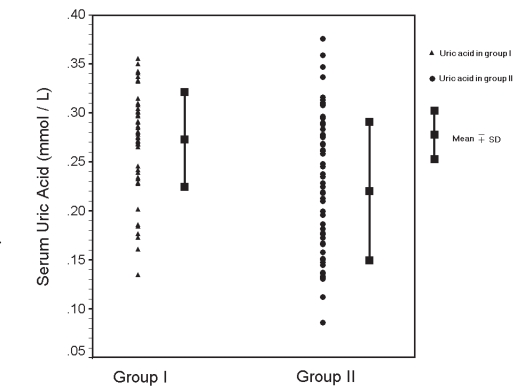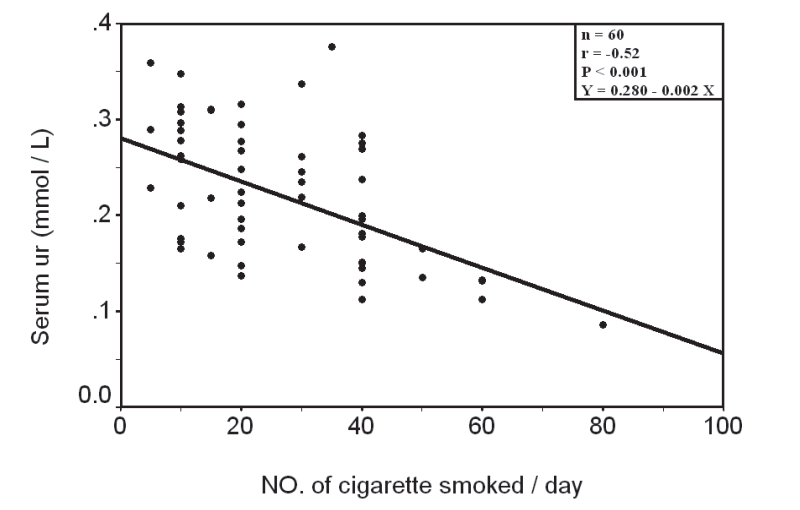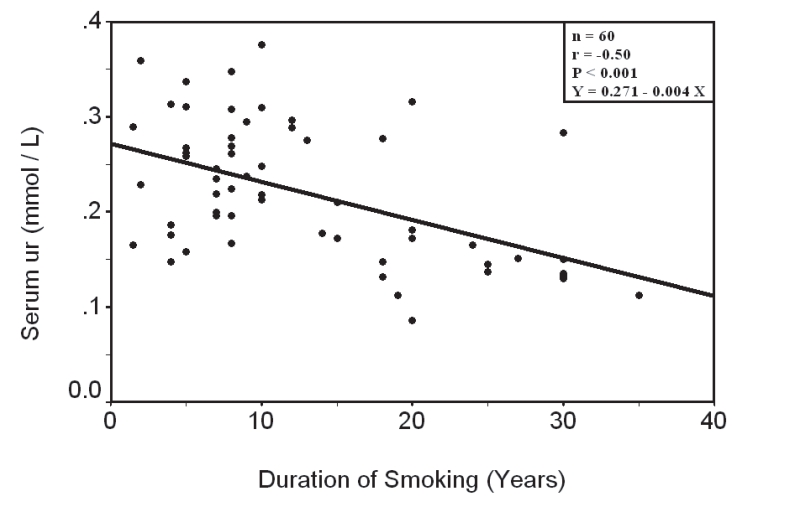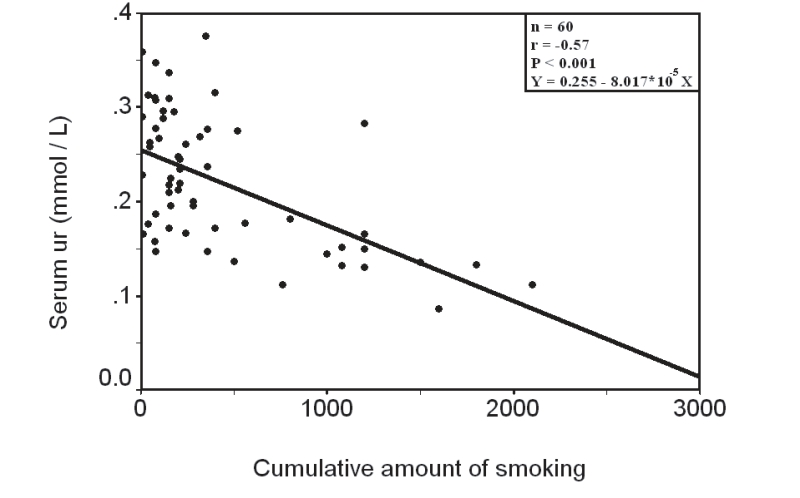Abstract
Objectives
To demonstrate the possible effect of smoking on serum uric acid.
Methods
Subjects enrolled in study were divided into two groups; nonsmokers and smokers, each with 60 male volunteers of the same social class and dietary habit without history of alcohol consumption, diabetes mellitus, hyperuricemia and gout, renal, joint, lung or heart diseases. Fasting blood and random urine samples were obtained from both groups for measurement of uric acid and creatinine. Calculation of both urine uric acid/urine creatinine ratio and fraction excretion of uric acid were done. The results were statistically evaluated by standard statistical methods.
Results
No significant differences in the age, serum creatinine, spot urine uric acid/urine creatinine ratio and fraction excretion of uric acid between the two groups, serum uric acid was significantly lower in smokers. In smokers there was significant negative correlation of smoking status (average number of cigarette smoked/day, duration of smoking and cumulative amount of smoking) with serum uric acid.
Conclusion
After exclusion of other factors affecting uric acid level, the significant low serum uric acid level in smokers was attributed to reduce endogenous production as a result of chronic exposure to cigarette smoke that is a significant source of oxidative stress. As this reduction is proportionate with smoking status and predisposes to cardiovascular disease, it is, therefore, recommended for smokers to stop or reduce smoking and introduce serum uric acid estimation as routine test since its cheap and simple to reflect their antioxidant level.
Keywords
Smokers; Uric acid; CVD.
Introduction
Cigarette-smoking is a well-known risk factor for atherosclerosis development and its complications including cerebral and cardiovascular diseases(CVD)1,2 through vascular endothelial damage3 that possibly occurs through oxygen free radicals production as superoxide radicals, hydrogen peroxide and hydroxyl radicals.4,5 Several enzymes capable of producing oxygen free radicals including xanthine oxidase, NADPH oxidase, myeloperoxidase, and endotoxin.4,5
As cigarette smoke contains superoxide and reactive nitrogen species that readily react with various biomolecules,1,6-9 it has been hypothesized that some of the adverse effects of smoking may result from oxidative damage to endothelial cells, which results in nitric oxide (NO) shortage.1,10,11 (NO) shortage regulates vascular tone that accelerates insufficiency of coronary artery and vasoconstriction in many different tissues.3,12 Therefore imbalance between oxidants and antioxidants may play an important role in the susceptible smoker.13,14 In addition cigarette smokers have increased inflammatory responses that further enhance their oxidative stress.8,9
Since in humans, uric acid is the most abundant aqueous antioxidant, accounting for up to 60% of serum free radical scavenging capacity15 and is an important intracellular free radical scavenger during metabolic stress including smoking,16,17 therefore, measurement of its serum level reflects the antioxidant capacity.15
The aim of this study is to demonstrate the possible effect of smoking on serum uric acid concentration.
Methods
The study was conducted during the period from March to June 2008, the subjects enrolled in this study were divided into two groups (group I and group II).
Group I, considered as a control group, was composed of 60 apparently healthy nonsmoker male volunteers, their ages ranged from 20 to 69 years.
Group II, considered as a smoker group composed of 60 cigarette-smoker male volunteers, their ages ranged from 16 to 71 years.
A complete record of history was obtained, including name, age, average number of daily cigarettes smoked daily, duration of smoking, dietary habit, alcohol consumption, social class, past medical and drug history.
Members of both groups were within the same social class and dietary habit with no history of alcohol consumption, diabetes mellitus, hyperuricemia and gout, renal, joint, lung or heart diseases.
Fasting blood and random urine samples were obtained from both groups for colorimetric measurement of uric acid and creatinine that were done by Jaffe’s reaction kinetic method18 using a kit supplied by Biolabo Company and by uricase method18 using a kit supplied by Biomeriux Company respectively by obtaining absorbencies using Cecil spectrophotometer-CE 1011 at the Biochemistry Laboratory of Nineveh College of Medicine in Mosul, Iraq.
From the data of serum and urine uric acid and creatinine the calculation of both urine uric acid/urine creatinine (Uuric acid/Ucreatinine) ratio19 and fraction excretion of uric acid (FEuric acid)19,20 were done in both groups, calculation of FEuric acid was done by the following formula:19,20
| FEuric acid = (Uuric acid*Screatinine/Suric acid* Ucreatinine)*100 |
The results were statistically evaluated by standard statistical methods including mean, standard deviation (SD) range (minimum-maximum), Linear regression analysis (Pearson correlation coefficient r), student’s t-test21,22 with computer software programs including Microsoft Excel 2003 and SPSS 11.5 to evaluate the relation between different parameters of both groups. 23 Differences between observations were considered not significant at p> 0.05.
Results
No statistical significant differences were noted in the age, serum creatinine, spot Uuric acid/Ucreatinine ratio and FEuric acid between two groups (P>0.05, Table 1), whereas serum uric acid was significantly lower in group II than group I (P<0.001, Table 1, Fig.1).
Table 1. Comparison between parameters of both groups; Values are presented as mean ± SD.
| Parameter | Group I (Control) n = 60 |
Group II (Smokers) n = 60 |
p value |
|---|---|---|---|
| Age (years) | 33.50 ± 11.80 | 36.10 ± 12.00 | >0.05 |
| Serum creatinine (µmol/L) | 96.82 ± 17.87 | 89.84 ± 29.16 | >0.05 |
| Serum uric acid (mmol/L) | 0.27 ± 0.05 | 0.22 ± 0.07 | <0.001 |
| Uuric acid/Ucrearitine | 0.43 ± 0.11 | 0.41 ± 0.17 | >0.05 |
| FEuric acid (%) | 10.21 ± 2.38 | 11.85 ± 6.16 | >0.05 |
Figure 1.
Spread of uric acid levels in group I and group II
The coefficient of variations of serum uric acid and creatinine were 17.68 and 18.46 in group I and 32.14 and 32.46 in group II respectively.
Table 2 demonstrates the mean ± SD and the range of smoking status in group II including the average number of cigarettes smoked/day, duration of smoking and cumulative amount of smoking (calculated by multiplying the number of cigarettes smoked/day with the duration of smoking).
Table 2. Smoking status in group II; Values are presented as mean ± SD.
| Parameter | Mean ± SD | Range |
|---|---|---|
| Number of cigarette/day | 26.75 ± 16.41 | 5 - 80 |
| Duration of smoking (Years) | 12.75 ± 8.86 | 1.5 -35 |
| Cumulative amount of smoking | 432.63 ± 499.58 | 7.5 - 2100 |
In group II, a statistical significant negative correlations were noted between smoking status parameters and serum uric acid (P<0.001, Fig. 2, Fig. 3, Fig. 4), no such correlations with serum creatinine (p>0.050).
Figure 2.
Correlation between serum uric acid and number of cigarette smoked/day in group II
Figure 3.
Correlation between serum uric acid and duration of smoking in group II
Figure 4.
Correlation between serum uric acid and cumulative amount of smoking in group II
Discussion
Many but not all epidemiological studies have suggested that high serum uric acid is a risk factor for CVD24-28 and warranted to evaluate its prognostic implications and potential utility in the monitoring of therapy.29 This raised level of serum uric acid parallel to an increased risk of CVD could be either primary or secondary to underlying causes of CVD.30-35 However, the specific role of serum uric acid in this constellation remains uncertain36 although may be involved in platelet adhesiveness, aggregation or inflammation37-39 and may be implicated in the genesis of hypertension.40
In contrast, there is some evidence suggesting that the increase of serum uric acid is protective against CVD since uric acid acts as an endogenous antioxidant41-43 and the higher serum uric acid levels found in CVD patients suggests that any protective antioxidant effect which uric acid has is overwhelmed by other negative effects on pathogenesis.44 Recently the viability of administering uric acid in solution has been established41even they do not specifically address the question of a biological link between uric acid and mechanisms of endothelial dysfunction or atherosclerosis since inhibition of xanthine oxidase by allopurinol is likely to reduce the production of hydrogen peroxide and thereby ameliorate oxidative stress even in smokers45 independent of its effects on uric acid.46 Furthermore, allopurinol has antioxidant properties.47 Therefore, raising serum uric acid concentrations protects against acute oxidative damage as in smoking.48
In this study, although serum uric acid level in smokers did not reach the lower reference range (0.12 mmol/L)49 however it is significantly lower than the nonsmoker group (P<0.001) and has significant negative correlation with smoking status including the average number of cigarettes smoked/day, duration of smoking and cumulative amount of smoking. This finding is in agreement with other studies that showed low serum uric acid in regular smokers1,50 and reduction of antioxidants including uric acid in smokers51,52 indicating that oxidative stress increases everytime a cigarette is smoked.1 Other studies proved that even nonsmokers exposed to cigarette smoke have a significantly lower plasma antioxidant status than unexposed nonsmokers do, independent of differences in dietary antioxidant intakes.51 It even proved that administration of uric acid raises circulating antioxidant defenses and allows restoration of endothelium-dependent vasodilation.11,52 Therefore, high serum uric acid concentrations might be protective in situations characterized by increased cardiovascular risk and oxidative stress as smoking,11 and by reducing its level it increases susceptibility to oxidative damage and accounts for the excessive free radical production.53 Therefore, the possibility that uric acid confers protection against the development of atherosclerosis, in view of its antioxidant properties, has been recognized.54,55
In this study, serum creatinine, FEuric acid and Uuric acid/Ucreatinine ratio are not significantly differ between two groups, in addition to that FEuric acid and Uuric acid/Ucreatinine ratio values lie within the mean ± SD observed in the control group by other studies.19,56-58 Since these tests have been reported to be useful to evaluate renal handling of uric acid59-63 and as serum uric acid concentrations are highly dependent on endogenous production as well as renal excretion.64,65 Therefore, low serum uric acid level in smokers is attributed to reduction of endogenous production. As result of smoking, oxidative stress consumption rather than increased renal excretion after exclusion of other factors that affect its level as all members of groups I and II are subjected to the same preanalytical and postanalytical factors and all of them are within the same social class, dietary habit with no history of alcohol consumption in addition to standardization of laboratory uric acid measurement to avoid analytical variations.
This finding is in agreement with other studies that proved that reduction of antioxidants including uric acid in smokers66 is due to both chronic exposure to cigarette smoke that is a significant source of oxidative stress8,53 and low intake of dietary antioxidants.67
Conclusion
After exclusion of other factors affecting uric acid level, the significant low serum uric acid level in smokers was attributed to reduce endogenous production as a result of chronic exposure to cigarette smoke that is a significant source of oxidative stress. As this reduction is proportionate with smoking status and predisposes to cardiovascular disease, it is recommended for smokers to stop or reduce smoking and introduce serum uric acid estimation as routine test since its cheap and simple to reflect their antioxidant level.
References
- 1.Tsuchiya M, Asada A, Kasahara E, Sato EF, Shindo M, Inoue M. Smoking a single cigarette rapidly reduces combined concentrations of nitrate and nitrite and concentrations of antioxidants in plasma. Circulation 2002. Mar;105(10):1155-1157 10.1161/hc1002.105935 [DOI] [PubMed] [Google Scholar]
- 2.Celermajer DS, Sorensen KE, Georgakopoulos D, Bull C, Thomas O, Robinson J, et al. Cigarette smoking is associated with dose-related and potentially reversible impairment of endothelium-dependent dilation in healthy young adults. Circulation 1993. Nov;88(5 Pt 1):2149-2155 [DOI] [PubMed] [Google Scholar]
- 3.Benzuly KH, Padgett RC, Kaul S, Piegors DJ, Armstrong ML, Heistad DD. Functional improvement precedes structural regression of atherosclerosis. Circulation 1994. Apr;89(4):1810-1818 [DOI] [PubMed] [Google Scholar]
- 4.Calver A, Collier J, Moncada S, Vallance P. Effect of local intra-arterial NG-monomethyl-L-arginine in patients with hypertension: the nitric oxide dilator mechanism appears abnormal. J Hypertens 1992. Sep;10(9):1025-1031 [PubMed] [Google Scholar]
- 5.Kanani PM, Sinkey CA, Browning RL, Allaman M, Knapp HR, Haynes WG. Role of oxidant stress in endothelial dysfunction produced by experimental hyperhomocyst(e)inemia in humans. Circulation 1999. Sep;100(11):1161-1168 [DOI] [PubMed] [Google Scholar]
- 6.Karnath B. Smoking cessation. Am J Med 2002. Apr;112(5):399-405 10.1016/S0002-9343(01)01126-3 [DOI] [PubMed] [Google Scholar]
- 7.Pryor WA. Cigarette smoke radicals and the role of free radicals in chemical carcinogenicity. Environ Health Perspect 1997. Jun;105(Suppl 4):875-882 [DOI] [PMC free article] [PubMed] [Google Scholar]
- 8.Alberg A. The influence of cigarette smoking on circulating concentrations of antioxidant micronutrients. Toxicology 2002. Nov;180(2):121-137 10.1016/S0300-483X(02)00386-4 [DOI] [PubMed] [Google Scholar]
- 9.Brown KM, Morrice PC, Duthie GG. Erythrocyte vitamin E and plasma ascorbate concentrations in relation to erythrocyte peroxidation in smokers and nonsmokers: dose response to vitamin E supplementation. Am J Clin Nutr 1997. Feb;65(2):496-502 [DOI] [PubMed] [Google Scholar]
- 10.Node K, Kitakaze M, Yoshikawa H, Kosaka H, Hori M. Reversible reduction in plasma concentration of nitric oxide induced by cigarette smoking in young adults. Am J Cardiol 1997. Jun;79(11):1538-1541 10.1016/S0002-9149(97)00189-6 [DOI] [PubMed] [Google Scholar]
- 11.Waring WS, McKnight JA, Webb DJ, Maxwell SR. Uric acid restores endothelial function in patients with type 1 diabetes and regular smokers. Diabetes 2006. Nov;55(11):3127-3132 10.2337/db06-0283 [DOI] [PubMed] [Google Scholar]
- 12.Schectman G, Byrd JC, Gruchow HW. The influence of smoking on vitamin C status in adults. Am J Public Health 1989. Feb;79(2):158-162 10.2105/AJPH.79.2.158 [DOI] [PMC free article] [PubMed] [Google Scholar]
- 13.van der Vaart H, Postma DS, Timens W, ten Hacken NH. Acute effects of cigarette smoke on inflammation and oxidative stress: a review. Thorax 2004. Aug;59(8):713-721 10.1136/thx.2003.012468 [DOI] [PMC free article] [PubMed] [Google Scholar]
- 14.Polidori MC, Mecocci P, Stahl W, Sies H. Cigarette smoking cessation increases plasma levels of several antioxidant micronutrients and improves resistance towards oxidative challenge. Br J Nutr 2003. Jul;90(1):147-150 10.1079/BJN2003890 [DOI] [PubMed] [Google Scholar]
- 15.Maxwell SR, Thomason H, Sandler D, Leguen C, Baxter MA, Thorpe GH, et al. Antioxidant status in patients with uncomplicated insulin-dependent and non-insulin-dependent diabetes mellitus. Eur J Clin Invest 1997. Jun;27(6):484-490 10.1046/j.1365-2362.1997.1390687.x [DOI] [PubMed] [Google Scholar]
- 16.Mathru M, Dries DJ, Barnes L, Tonino P, Sukhani R, Rooney MW. Tourniquet-induced exsanguination in patients requiring lower limb surgery. An ischemia-reperfusion model of oxidant and antioxidant metabolism. Anesthesiology 1996. Jan;84(1):14-22 10.1097/00000542-199601000-00003 [DOI] [PubMed] [Google Scholar]
- 17.Hellsten Y, Tullson PC, Richter EA, Bangsbo J. Oxidation of urate in human skeletal muscle during exercise. Free Radic Biol Med 1997;22(1-2):169-174 10.1016/S0891-5849(96)00286-9 [DOI] [PubMed] [Google Scholar]
- 18.Whelton A, Watson JA, Robert RC. Nitrogen metabolism and renal function. In: Tietz fundamentals of clinical chemistry (Burtis CA, Ashwood ER, eds). 4th ed. Saunders com 1996; 578-580. [Google Scholar]
- 19.Perez-Ruiz F, Calabozo M, Erauskin GG, Ruibal A, Herrero-Beites AM. Renal underexcretion of uric acid is present in patients with apparent high urinary uric acid output. Arthritis Rheum 2002. Dec;47(6):610-613 10.1002/art.10792 [DOI] [PubMed] [Google Scholar]
- 20.Shichiri M, Hirata Y. Serum uric acid level and fractional excretion of urate in fluid and electrolyte disturbances. Rinsho Byori 1999. May;47(5):417-423 [PubMed] [Google Scholar]
- 21.Chap TLE. Introductory biostatistics. Wiely interscience 2003; 283 – 292.
- 22.Jones D. Pharmaceutical statistics. Pharmaceutical press 2002.
- 23.Landau S, Everitt BS. A Handbook of Statistical Analyses using SPSS. A CRC Press Company USA 2003. [Google Scholar]
- 24.Freedman DS, Williamson DF, Gunter EW, Byers T. Relation of serum uric acid to mortality and ischemic heart disease. The NHANES I Epidemiologic Follow-up Study. Am J Epidemiol 1995. Apr;141(7):637-644 [DOI] [PubMed] [Google Scholar]
- 25.Culleton BF, Larson MG, Kannel WB, Levy D. Serum uric acid and risk for cardiovascular disease and death: the Framingham Heart Study. Ann Intern Med 1999. Jul;131(1):7-13 [DOI] [PubMed] [Google Scholar]
- 26.Rich MW. Uric acid: is it a risk factor for cardiovascular disease? Am J Cardiol 2000. Apr;85(8):1018-1021 10.1016/S0002-9149(99)00922-4 [DOI] [PubMed] [Google Scholar]
- 27.Fang J, Alderman MH. Serum uric acid and cardiovascular mortality the NHANES I epidemiologic follow-up study, 1971-1992. National Health and Nutrition Examination Survey. JAMA 2000. May;283(18):2404-2410 10.1001/jama.283.18.2404 [DOI] [PubMed] [Google Scholar]
- 28.Meisinger C, Koenig W, Baumert J, Döring A. Uric acid levels are associated with all-cause and cardiovascular disease mortality independent of systemic inflammation in men from the general population: the MONICA/KORA cohort study. Arterioscler Thromb Vasc Biol 2008. Jun;28(6):1186-1192 10.1161/ATVBAHA.107.160184 [DOI] [PubMed] [Google Scholar]
- 29.Ioachimescu AG, Brennan DM, Hoar BM, Hazen SL, Hoogwerf BJ. Serum uric acid is an independent predictor of all-cause mortality in patients at high risk of cardiovascular disease: a preventive cardiology information system (PreCIS) database cohort study. Arthritis Rheum 2008. Feb;58(2):623-630 10.1002/art.23121 [DOI] [PubMed] [Google Scholar]
- 30.Whitelaw DC, O’Kane M, Wales JK, Barth JH. Risk factors for coronary heart disease in obese non-diabetic subjects. Int J Obes Relat Metab Disord 2001. Jul;25(7):1042-1046 10.1038/sj.ijo.0801596 [DOI] [PubMed] [Google Scholar]
- 31.Johnson RJ, Kang DH, Feig D, Kivlighn S, Kanellis J, Watanabe S, et al. Is there a pathogenetic role for uric acid in hypertension and cardiovascular and renal disease? Hypertension 2003. Jun;41(6):1183-1190 10.1161/01.HYP.0000069700.62727.C5 [DOI] [PubMed] [Google Scholar]
- 32.Johnson RJ, Feig DI, Herrera-Acosta J, Kang DH. Resurrection of uric acid as a causal risk factor in essential hypertension. Hypertension 2005. Jan;45(1):18-20 [DOI] [PubMed] [Google Scholar]
- 33.Wheeler JG, Juzwishin KD, Eiriksdottir G, Gudnason V, Danesh J. Serum uric acid and coronary heart disease in 9,458 incident cases and 155,084 controls: prospective study and meta-analysis. PLoS Med 2005. Mar;2(3):e76 10.1371/journal.pmed.0020076 [DOI] [PMC free article] [PubMed] [Google Scholar]
- 34.Ruggiero C, Cherubini A, Ble A, Bos AJ, Maggio M, Dixit VD, et al. Uric acid and inflammatory markers. Eur Heart J 2006. May;27(10):1174-1181 10.1093/eurheartj/ehi879 [DOI] [PMC free article] [PubMed] [Google Scholar]
- 35.Kawamoto R, Tomita H, Oka Y, Ohtsuka N. Relationship between serum uric acid concentration, metabolic syndrome and carotid atherosclerosis. Intern Med 2006;45(9):605-614 10.2169/internalmedicine.45.1661 [DOI] [PubMed] [Google Scholar]
- 36.Dzielak DJ, Kivlighn SD. Emerging concepts in cardiovascular disease: should elevated serum uric acid be considered a risk factor? Expert Opin Investig Drugs 1998. Jan;7(1):85-89 10.1517/13543784.7.1.85 [DOI] [PubMed] [Google Scholar]
- 37.Mustard JF, Murphy EA, Ogryzlo MA, Smythe HA. Blood coagulation and platelet economy in subjects with primary gout. Can Med Assoc J 1963. Dec;89:1207-1211 [PMC free article] [PubMed] [Google Scholar]
- 38.Newland H. Hyperuricemia in coronary, cerebral and peripheral arterial disease: an explanation. Med Hypotheses 1975. Jul-Aug;1(4):152-155 10.1016/0306-9877(75)90011-0 [DOI] [PubMed] [Google Scholar]
- 39.Selby JV, Friedman GD, Quesenberry CP., Jr Precursors of essential hypertension: pulmonary function, heart rate, uric acid, serum cholesterol, and other serum chemistries. Am J Epidemiol 1990. Jun;131(6):1017-1027 [DOI] [PubMed] [Google Scholar]
- 40.Nicholls A, Snaith ML, Scott JT. Effect of oestrogen therapy on plasma and urinary levels of uric acid. Br Med J 1973. Feb;1(5851):449-451 10.1136/bmj.1.5851.449 [DOI] [PMC free article] [PubMed] [Google Scholar]
- 41.Waring WS, Webb DJ, Maxwell SR. Systemic uric acid administration increases serum antioxidant capacity in healthy volunteers. J Cardiovasc Pharmacol 2001. Sep;38(3):365-371 10.1097/00005344-200109000-00005 [DOI] [PubMed] [Google Scholar]
- 42.Maxwell AJ, Bruinsma KA. Uric acid is closely linked to vascular nitric oxide activity. Evidence for mechanism of association with cardiovascular disease. J Am Coll Cardiol 2001. Dec;38(7):1850-1858 10.1016/S0735-1097(01)01643-6 [DOI] [PubMed] [Google Scholar]
- 43.Schretlen DJ, Inscore AB, Jinnah HA, Rao V, Gordon B, Pearlson GD. Serum uric acid and cognitive function in community-dwelling older adults. Neuropsychology 2007. Jan;21(1):136-140 10.1037/0894-4105.21.1.136 [DOI] [PubMed] [Google Scholar]
- 44.Torun M, Yardım S, Simsek B, Burgaz S. Serum uric acid levels in cardiovascular diseases. J Clin Pharm Ther 1998. Feb;23(1):25-29 10.1046/j.1365-2710.1998.00125.x [DOI] [PubMed] [Google Scholar]
- 45.Guthikonda S, Sinkey C, Barenz T, Haynes WG, American Heart Association Clinical Investigation and Reports Xanthine oxidase inhibition reverses endothelial dysfunction in heavy smokers. Circulation 2003. Jan;107(3):416-421 10.1161/01.CIR.0000046448.26751.58 [DOI] [PubMed] [Google Scholar]
- 46.Desco MC, Asensi M, Márquez R, Martínez-Valls J, Vento M, Pallardó FV, et al. Xanthine oxidase is involved in free radical production in type 1 diabetes: protection by allopurinol. Diabetes 2002. Apr;51(4):1118-1124 10.2337/diabetes.51.4.1118 [DOI] [PubMed] [Google Scholar]
- 47.Ricardo SD, Bertram JF, Ryan GB. Podocyte architecture in puromycin aminonucleoside-treated rats administered tungsten or allopurinol. Exp Nephrol 1995. Sep-Oct;3(5):270-279 [PubMed] [Google Scholar]
- 48.Waring WS, Convery A, Mishra V, Shenkin A, Webb DJ, Maxwell SR. Uric acid reduces exercise-induced oxidative stress in healthy adults. Clin Sci (Lond) 2003. Oct;105(4):425-430 10.1042/CS20030149 [DOI] [PubMed] [Google Scholar]
- 49.Boon NA, Colledqe NR, Walker BR, Hunter J. Davidson’s principle and practice of medicine. Churchill livinqstone 2006: 1320.
- 50.Timimi FK, Ting HH, Haley EA, Roddy MA, Ganz P, Creager MA. Vitamin C improves endothelium-dependent vasodilation in patients with insulin-dependent diabetes mellitus. J Am Coll Cardiol 1998. Mar;31(3):552-557 10.1016/S0735-1097(97)00536-6 [DOI] [PubMed] [Google Scholar]
- 51.Dietrich M, Block G, Norkus EP, Hudes M, Traber MG, Cross CE, et al. Smoking and exposure to environmental tobacco smoke decrease some plasma antioxidants and increase gamma-tocopherol in vivo after adjustment for dietary antioxidant intakes. Am J Clin Nutr 2003. Jan;77(1):160-166 [DOI] [PubMed] [Google Scholar]
- 52.Goraca A, Skibska B. Plasma antioxidant status in healthy smoking and non-smoking men. Bratisl Lek Listy 2005;106(10):301-306 [PubMed] [Google Scholar]
- 53.Reilly M, Delanty N, Lawson JA, FitzGerald GA. Modulation of oxidant stress in vivo in chronic cigarette smokers. Circulation 1996. Jul;94(1):19-25 [DOI] [PubMed] [Google Scholar]
- 54.Becker BF. Towards the physiological function of uric acid. Free Radic Biol Med 1993. Jun;14(6):615-631 10.1016/0891-5849(93)90143-I [DOI] [PubMed] [Google Scholar]
- 55.Nieto FJ, Iribarren C, Gross MD, Comstock GW, Cutler RG. Uric acid and serum antioxidant capacity: a reaction to atherosclerosis? Atherosclerosis 2000. Jan;148(1):131-139 10.1016/S0021-9150(99)00214-2 [DOI] [PubMed] [Google Scholar]
- 56.Pak CY. Renal Calculi. In: Cecil Textbook of Medicine, Volume 1 (Wyngaarden JB and Smith LH Jr). 18th ed. Philadelphia PA: WB Saunders com 988; 638-644. [Google Scholar]
- 57.Pesce AJ, Kaplan LA. Methods in Clinical Chemistry, St Louis, MO: Mosby-Year Book Inc, 1987, 32. [Google Scholar]
- 58.Katopodis KP, Elisaf MS, Pappas HA, Theodorou JC, Milionis HJ, Bourantas KL, et al. Renal abnormalities in patients with sickle cell-beta thalassemia. J Nephrol 1997. May-Jun;10(3):163-167 [PubMed] [Google Scholar]
- 59.Puig JG, Mateos FA, Jiménez ML, Ramos TH. Renal excretion of hypoxanthine and xanthine in primary gout. Am J Med 1988. Oct;85(4):533-537 10.1016/S0002-9343(88)80091-3 [DOI] [PubMed] [Google Scholar]
- 60.Nishida Y, Ito K. Decreased renal phosphate threshold in patients with gout. Nephron 1992;62(2):142-144 10.1159/000187022 [DOI] [PubMed] [Google Scholar]
- 61.Emmerson BT. The management of gout. N Engl J Med 1996. Feb;334(7):445-451 10.1056/NEJM199602153340707 [DOI] [PubMed] [Google Scholar]
- 62.Tykarski A. Evaluation of renal handling of uric acid in essential hypertension: hyperuricemia related to decreased urate secretion. Nephron 1991;59(3):364-368 10.1159/000186593 [DOI] [PubMed] [Google Scholar]
- 63.Perez-Ruiz F, Calabozo M, Herrero A, Ruiz-Lucea E, Alonso Ruiz A. Analysis of the methods for classifying gout according to renal excretion of uric acid. Rev Esp Reumatol 1998;25:335-339 [Google Scholar]
- 64.Leyva F, Wingrove CS, Godsland IF, Stevenson JC. The glycolytic pathway to coronary heart disease: a hypothesis. Metabolism 1998. Jun;47(6):657-662 10.1016/S0026-0495(98)90026-9 [DOI] [PubMed] [Google Scholar]
- 65.Quiñones Galvan A, Natali A, Baldi S, Frascerra S, Sanna G, Ciociaro D, et al. Effect of insulin on uric acid excretion in humans. Am J Physiol 1995. Jan;268(1 Pt 1):E1-E5 [DOI] [PubMed] [Google Scholar]
- 66.Tomita M, Mizuno S, Yokota K. Increased levels of serum uric acid among ex-smokers. J Epidemiol 2008;18(3):132-134 10.2188/jea.JE2006332 [DOI] [PMC free article] [PubMed] [Google Scholar]
- 67.Bloomer RJ. Decreased blood antioxidant capacity and increased lipid peroxidation in young cigarette smokers compared to nonsmokers: Impact of dietary intake. Nutr J 2007;6:39 10.1186/1475-2891-6-39 [DOI] [PMC free article] [PubMed] [Google Scholar]






